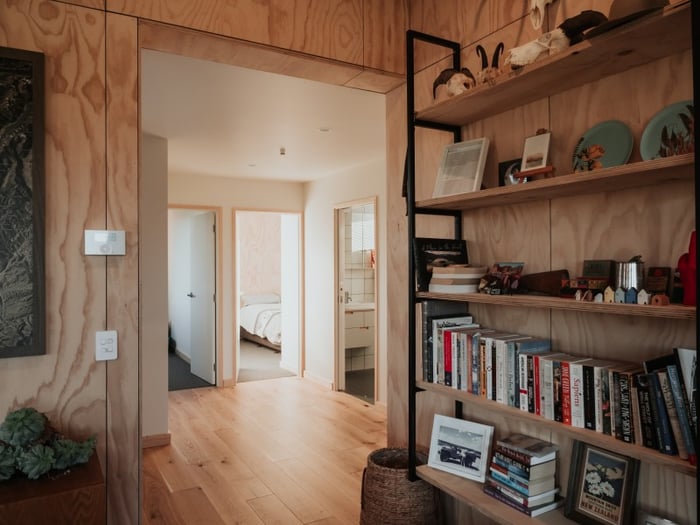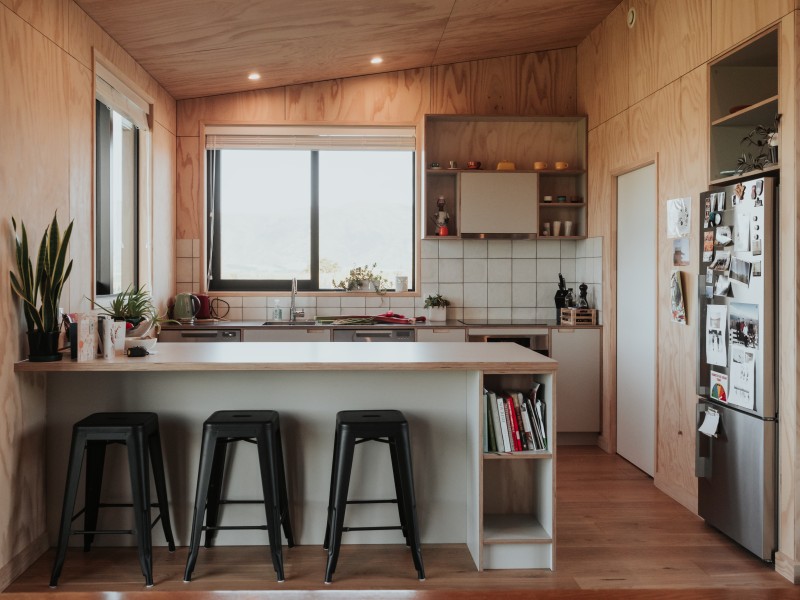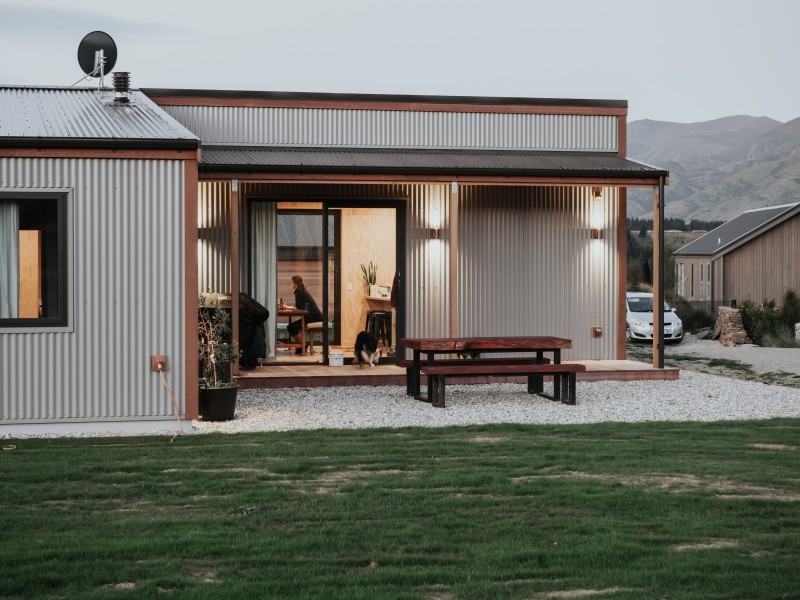Wānaka architect Beth Chaney-Walker believes improving how we build our houses is one of the best ways we can reduce our carbon footprint. So when she designed her own family home in Luggate two years ago sustainability was the headline act.
Recently awarded an 8 Homestar rating she says the stunning Central Otago views from her house are a daily reminder that we should do everything we can to minimise the resources we use.
Essentials
Owner: Beth Chaney-Walker and Marc Walker.
What: domestic dwelling; 110 square metres; three bedrooms, office nook and one bathroom.
Where : Luggate, Central Otago.
Location: Luggate is small township located between Wānaka and Cromwell; 15 kilometres from Wānaka.
Occupancy: two people and a young child.
Project certification: 8 Homestar built rating (July 2022) 8 Homestar design rating (June 2020); the first 8 Homestar certified house in the wider Wānaka region.
Project Snapshot
Architect: Beth Chaney-Walker of Chaney & Norman Architects.
Main contractor: MDS Building + Construction Ltd.
Homestar professional: Beth Chaney-Walker of Chaney & Norman Architects.
Project timeline: design process complete: August 2019, construction start: January 2020, construction finish: September 2020.

Beth Chaney-Walker says being homeowner, architect and Homestar assessor when she and her husband Marc Walker built their sustainable family home gave her freedom to experiment.
“I really love the design and construction process and as an architect it was always my goal to design my own home,” says Beth.
“Having three roles of owner, architect and assessor was so unique and really beneficial as I could test out design ideas and see how these stacked up against our 8 Homestar target and budget.”
That testing out of ideas has delivered an 8 Homestar rating for Beth and Marc’s house which features high-level thermal performance, airtight construction and a mechanical ventilation system with heat recovery.
Equipped with smart green technology the small, stylish house references the couple’s love of the great outdoors.
“We really enjoy getting out into nature and wanted our home to share the characteristics of a backcountry hut. This was a primary driver for using plywood in the interior and also drove the decision to use corrugated iron as our exterior cladding with its simple and durable aesthetic. Inside we’ve aimed to create that intimate feel of a hut with small, functional spaces.”
.jpg?width=700&height=933&name=luggaterisehouse_homestar_exterior_home_image_(10).jpg)
From the outset Beth wanted the project to showcase how to achieve high performance outcomes on a modest budget, and how to fit a family home into a small footprint.
She also hoped the house would create a narrative about Homestar.
“Homestar has a holistic vision of sustainability which I really love. It rewards homes that perform well thermally and use little energy for heating and cooling as well as considering the wider impact of the materials used in construction. Homestar asks the questions - are these healthy materials we are using? Are they sustainably and ethically sourced?”
Beth says targeting an 8 Homestar rating for the project “felt like a great goal for us” with a good alignment between the type of house being built and what was achievable within budget.
“At our architectural practice we have sustainable design at the heart of our work and building my own home was a great opportunity to ‘walk the talk’.”
“The third party verification from NZGBC really appealed to me as rather than me just saying ‘our home is sustainable’ it has been awarded its 8 Homestar certification by independent audit.”
She says qualifying as a Homestar Assessor has been a natural extension of her work as an architect and using her own home as a case study has been a further progression.
When Beth moved to Wānaka eight years ago she says her thinking around “making homes as sustainable as possible because they’re part of our legacy for the next generation” was reinforced by the alpine environment.
With the region’s climate of extremes she says buildings are either designed to respond to the locality or become uncomfortable and expensive to live in.
Countering the local weather has underpinned the infrastructure of Luggate Rise House.
While optimising its orientation with appropriately-sized and shaded windows to maximise solar gain in winter while minimising overheating in summer, the house uses very high levels of insulation (in the roof, walls and below the slab) along with good quality glazing, an air tight layer to the walls and roof, and a highly efficient ventilation system. Standard thermally broken aluminium window joinery was used, with the performance significantly improved by sealing and taping the joints to achieve better airtightness, and recessing the windows into the wall framing to achieve much better thermal performance.
The L shaped configuration of the house mitigates the prevailing north-west wind in the summer and provides a sheltered outdoor courtyard to the south with uninterrupted views to the Pisa Range.
During the hot days of summer the couple runs the ventilation system in a ‘summer bypass’ mode - which means fresh air from outside isn’t pre-heated by the outgoing extract air. They also use this system to purge the home of heat overnight.
Beth says the high level of thermal performance in the house (an indoor weather station tracks temperature and air quality) maintains a comfortable year-round temperature. Even on the frostiest of days.

“We love waking up to a warm house on a frosty morning. Typically on a winter’s days first thing in the morning it can be down to minus 5 outside but 20 degrees inside. In Luggate we get periods of inversion - low cloud with no sun - and on these days we use the fire first thing in the morning. We typically only burn one log and then let the fire go out and the heat is then retained in the home for the rest of the day.”
She says the house is noticeably warm and comfortable.
“Guests often think there is a heater running when in reality it’s just the house retaining heat generated during the day.”
The house requires only “a small input of energy” to maintain its comfortable temperature and “our power bills reflect this.”
Third party energy modelling demonstrates the house requires one sixth of the energy of a standard New Zealand home to maintain a comfortable temperature of around 20 degrees.
Hiberna Ltd energy modeller and director, Jessica Eyers, says the house is a great example of a beautiful modest house on a budget that performs fantastically well.
“It’s a simple, meticulously-detailed design which has allowed for good execution on site as proven by the good blower door test result of 0.77 ACH @50pa - and this result despite standard thermally broken aluminium joinery,” she says.
“I’ve also been impressed with the careful consideration of the ventilation design and the scissor trusses in the house are a great solution that allows for a good depth of insulation while maintaining a sloping ceiling.”
Beth lists the key elements contributing to the 8 Homestar result as:
- thermal modelling during the design process and again at the completion of construction to test and refine how the house would perform
- air tightness testing during construction - “Achieving an airtight construction maximises the effectiveness and durability of our insulation.”
- careful selection of sustainable materials e.g. FSC and PEFC rated and with no harmful VOCs - “Sourcing some of these materials was our biggest challenge”.
- a cohesive project team - “We had a great builder and great team who all understood what we wanted to achieve”
For builder Matt Smith of MDS Building + Construction Ltd, Luggate Rise House was his first Homestar build.
“It has been great to play a part in a project which scored 8 stars. We were really impressed with the clever use of space in the house. It’s a small footprint house but it feels spacious and comfortable to live in, it’s low energy consumption and also really low maintenance,” says Matt.
Beth says her best piece of advice for anyone embarking on a Homestar design and build project is to find the right fit with your architect.
“I think there are real efficiencies to be gained from having an architect who is also a Homestar Assessor or is very familiar with Homestar requirements. This means that key elements required for Homestar can be integral with the design of the home rather than treated as an add-on afterwards - which is far less efficient to do and far less successful in terms of the homes performance.”
The highlight of the project, she says, has been the end result.
“I’m so happy with the performance of our home and being able to live in such a comfortable building and I feel very lucky to have had the opportunity to experiment with design ideas at the outset.”
Beth say a valuer specialising in high performance homes has estimated the house is worth more than the couple anticipated.
“But for me the huge value of our home is having had it independently audited by NZGBC and being awarded an 8 Homestar rating.”
.jpg?width=3888&height=5184&name=luggaterisehouse_homestar_exterior_home_image_(1).jpg)
Photography by Andrew Urquhart.
